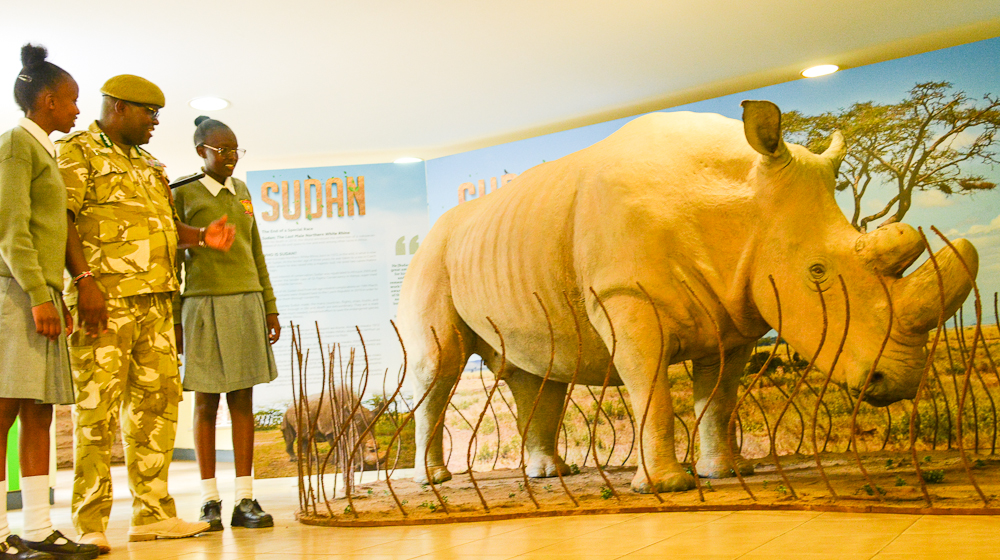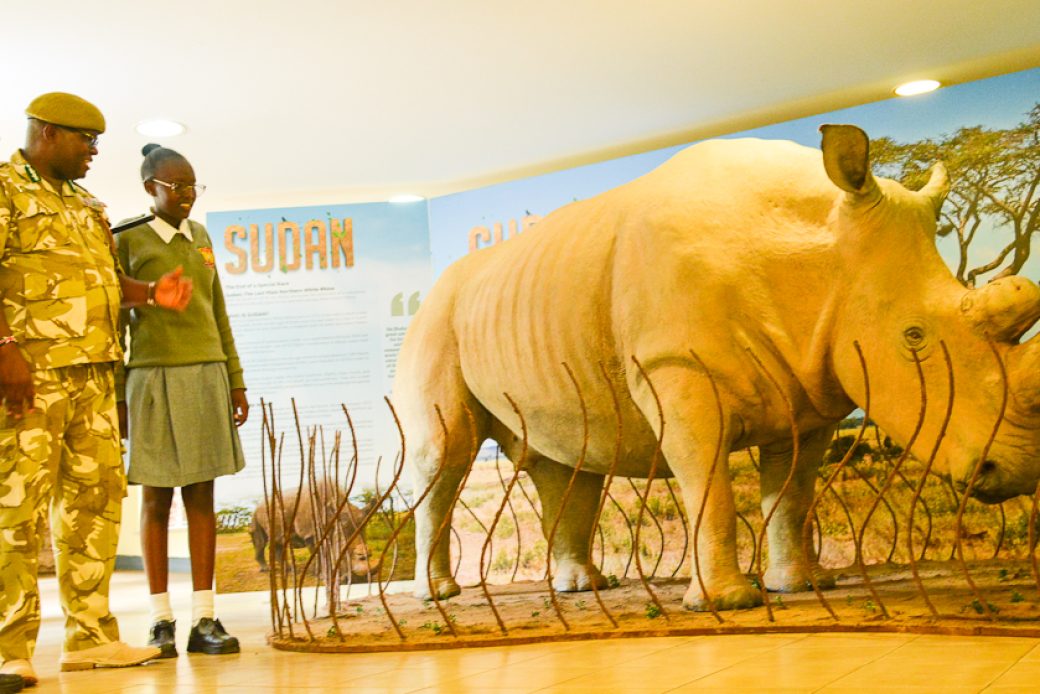The taxidermy of the last male Northern White Rhino (NWR) known to the world, named “Sudan” was Tuesday, March 28, 2023 officially received by the Cabinet Secretary for Tourism, Wildlife and Heritage, Hon. Peninah Malonza from Czech Republic Ambassador to Kenya, HE. Martin Klepteko and displayed for public viewing at the National Museums of Kenya headquarters in Nairobi.
The laborious work and expertise to piece together the taxidermy was done in the Czech Republic following the demise of Sudan on March 18, 2018 at Ol Pejeta Wildlife Conservancy in Laikipia County. Through a multilateral agreement, ZOO Dvůr Králové organized the building of Sudan’s taxidermy for scientific and educational purposes. The taxidermy was finalized in 2021 and has been on display in the National Museum in Prague, Czech Republic. Last year, KWS and ZOO Dvůr Králové entered into a Donation Agreement that concluded how the taxidermy of Sudan would be donated and transferred to Kenya.
Speaking at the grand reception of the taxidermy, Hon. Malonza said though a sad moment that Kenya was receiving the taxidermy of Sudan which was the last northern white rhino male, “it will be a constant reminder that we will be judged by future generations if we don’t take the necessary efforts to save the species from extinction.” She added, “While Sudan’s taxidermy is a prized wildlife memorabilia, it also serves as a constant reminder to the Government and partners that supporting the conservation of our keystone species remains at the apex of our mandate.”
Touching on efforts to fight against the possibility of having Northern White Rhino species being extinct, the Cabinet Secretary said Kenya will continue to partner with Biorescue consortium of local and international scientists and conservationists to save the Northern White rhinos from extinction using novel technologies. The assisted reproduction project for the recovery of the NWR based at the Ol Pejeta Conservancy is being undertaken in collaboration with Kenya Wildlife Service , ZOO Dvůr Králové (Czech Republic), Leibniz Institute for Zoo and Wildlife Research (Germany) Avantea Laboratory (Italy), Osaka University (Japan) and Wildlife Research and Training institute (WRTI) and has so far made great milestones. Twelve ovum pick up missions have been undertaken since 2019 with 24 NWR embryos developed.
On behalf of the Government, Hon. Malonza extended Kenya’s gratitude to the Governments of the Czech Republic, Germany and Italy for collaborating with Kenya and the global conservation community to explore novel scientific methods of saving the Northern White Rhino from extinction. She exhorted the global community to join in the recovery efforts of the NWR and support conservation and management of other wildlife species.
Hon. Malonza commended KWS for remaining true to her call of duty in conservation and management of Kenya’s wildlife and their habitats. She urged relevant Government agencies and partners to continue supporting KWS in implementation of her mandate of conservation and management of wildlife and their habitats and enforcement of related laws and policies. The Cabinet Secretary noted with appreciation that despite the challenges experienced over the years, rhino poaching has been managed and positive growth rates achieved with the national rhino population estimated at 1,890 as at the end of 2022 (966 black, 922 Southern White and 2 Northern White rhinos).
In his remarks, KWS Acting Director General Dr. Erustus Kanga reiterated KWS’ determination to protect and nurture viable populations of rhino species. He stated, “As a Service charged with conserving Kenya’s wildlife in trust for all Kenyans, we shall not relent in achieving and maintaining zero incidents of poaching”. The DG said conserving wildlife species has its challenges, citing, a devastating drought over the past months that has ravaged almost all parts of the country, with wildlife bearing the brunt of lack of fodder and water. “It has not been easy and therefore I thank the national government, through our parent ministry for availing resources to distribute fodder to wildlife in the hardest hit areas”, he said.
Dr. Kanga traced the life journey of Sudan terming it a sweet-bitter history that humans should retrace in exploring better ways of conserving wildlife species:

THE JOURNEY OF SUDAN, LAST NORTHERN WHITE RHINO MALE
1975: Sudan was rescued from South Sudan and taken to ZOO Dvůr Králové, Czech Republic
1983: Sudan’s calf Nabire was born at ZOO Dvůr Králové
1989: Sudan’s calf Najin was born at ZOO Dvůr Králové. Najin is one of the only two surviving NWR.
2000s: There was a drop-in reproduction performance among the individuals held in zoos worldwide. This necessitated the introduction of some rhinos to a natural environment with the hope of prompting natural behaviour and consequently breeding.
2009: Sudan was one of the four NWR that were transported from ZOO Dvůr Králové to Ol Pejeta Conservancy, Kenya
2011 and 2012: Sudan mated with both Fatu and Najin but conception was not achieved owing to reproductive issues that were identified in 2014 in both females.
2018: Death of Sudan on 18th March 2018
2019: Sudan skin and skeleton transported to Czech Republic
2021: Sudan taxidermy completed and displayed in Czech Republic together with its skeleton
2023: Sudan taxidermy transported to Kenya on March 24, 2023 to be displayed at a central location accessible to all.
Speaking during the same occasion, KWS Board of Trustees chairman Lt. Gen. (Rtd) Walter Raria Koipaton commended all the stakeholders involved in the collaboration to deliver Sudan’s taxidermy back to Kenya.
He thanked the Government for fully constituting KWS Board of Trustees, and promised to lead other board members to guide management in innovating and upholding best management practices. Lt. Gen. (Rtd) Koipaton promised to work closely with the parent ministry of Tourism, Wildlife and Heritage to attain the organisation’s mandate as spelt out in the Wildlife Conservation and Management Act, 2013.
Voice of Tourism And Culture




